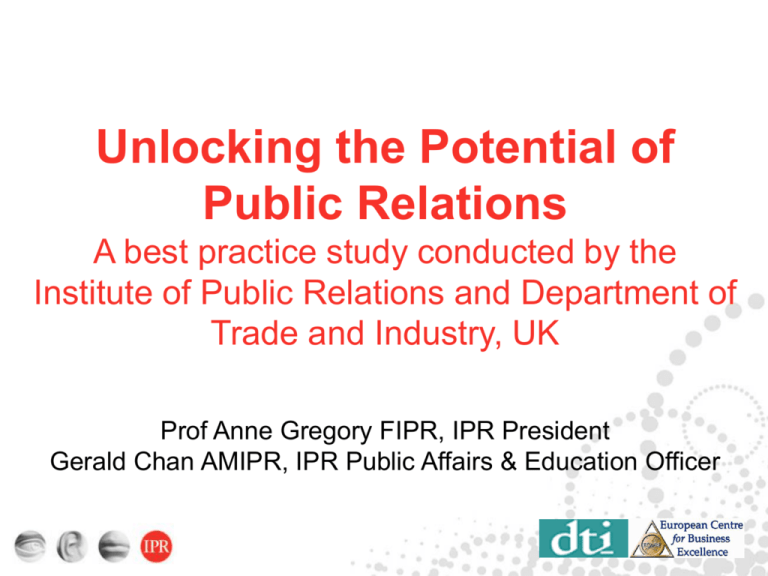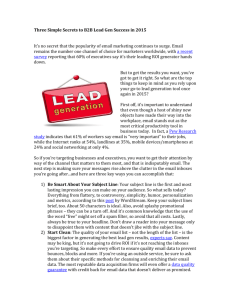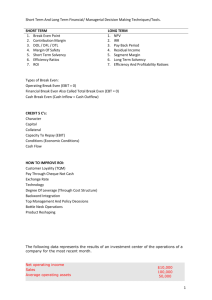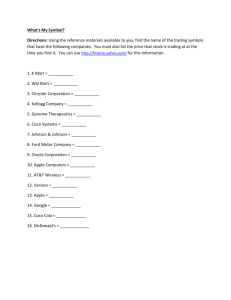Unlocking the Potential of Public Relations
advertisement

Unlocking the Potential of Public Relations A best practice study conducted by the Institute of Public Relations and Department of Trade and Industry, UK Prof Anne Gregory FIPR, IPR President Gerald Chan AMIPR, IPR Public Affairs & Education Officer A report by the DTI and the IPR www.ipr.org.uk/unlockpr In-house PR practitioners How well PR strategy supports the organisation’s overall strategy 45 Private Sector Mean = 3.85 Public Sector Mean = 4.19 40 40 35 27 Percent 30 29 31 32 25 20 17 15 10 5 4 4 7 5 3 1 0 1 not at all 2 3 4 5 6 fully Main purposes of PR and how effectively they are achieved PR Consultancies 1 = not at all, 6 = completely/absolutely What constitutes good PR practice? 120 elements of good PR practice identified covering: • • • • • • • • Strategy making Structure and organisation Commissioning and resources Research and planning Professionalism Creativity Technology Evaluation Effectiveness of audience research 40 33 34 35 30 Percent Private Sector Mean = 3.38 Public Sector Mean = 3.38 26 26 25 20 15 16 17 12 12 12 10 10 5 1 1 0 1 poor 2 3 4 5 6 excellent Importance of individual competencies for PR professionals 1 = not at all, 6 = very important Activities outsourced to PR agencies/ consultancies and to what extent 1 = all internal, 6 = all external Organisations running formal training and development programmes for PR professionals Consultancy In-house No 47% Yes 53% No 54% Yes 46% Future directions? Maximising the Potential of PR Professor Anne Gregory President, Institute of Public Relations & Director, Centre for PR Studies, Leeds Met. University and Dora McCabe Head of Group Public Relations Cadbury Schweppes plc www.ipr.org.uk/unlockpr DTI funded study of PR competitiveness @1,000 senior respondents Lots of best practice… But highlights some areas for major concern… Return on Investment (ROI): The ratio or percentage of how much profit or cost saving is realised from an activity against its total cost Measuring & Reporting in Public Relations An IPR and CDF study conducted by Metrica Research Ltd May 2004 Method & Sample Semi-structured phone survey of 100 senior Communication Director and CEO respondents 80 private sector 20 public sector Desk and web-based research on best practice & case studies Benefits of PR …long-term raise awareness build reputation improve business standing improve positioning against competitors …short-term raise awareness build reputation contribute to increased sales improve internal morale support other marketing activities Measuring PR Public sector In response to pressure for uniformity Combining internal teams & external agencies Using broad range of tools and techniques Private sector 44% conduct regular, planned & proactive measurement 31% conduct sporadic & reactive measurement 25% conduct one-off measures Improving PR Measurement 59% intend to improve PR assessment and monitoring but plans vague, poorly thought through and some just ‘tinkering’ Only 4 respondents cited firm and definite plans in place to improve PR measurement Measuring PR as ROI Half referred to some form of financial measure but… Significant proportion not confident about PR performance in terms of revenue or profit 8 out of 10 referred to ‘reach and frequency’ or ‘effect on audiences’ as main forms of measurement Measuring PR as ROI Only 6% claimed to measure PR in ROI related terms 34% did consider PR budgets in ROI terms 6 in 10 would use ROI to measure PR to… Measure performance Justify existing PR spend Prove need for additional PR spend PR ROI versus other communication measures Over 50% believe that PR ROI would lead to bigger budgets and create more opportunities for PR Up to 35% believe that PR ROI could be a threat and encourage budget restrictions > 15% believe that only AVEs can provide necessary ROI measures Others measure coverage (e.g. media analysis), reach and frequency or effect on audiences Recap: Measuring PR as ROI Majority believe in Tangible PR assessment Reporting Universal form of PR ROI Main issue is choosing what to measure and how to measure and report in ROI-type terms Does PR ROI make sense? ROI: Ratio or percentage of how much profit or cost saving is realised from an activity against its total cost Confusion over an agreed definition of ‘PR ROI’. Some examples of cost-savings and increased revenue Cost-benefits, where identified, defined in different ways Different perceptions about how to measure PR Translated into cost or revenue …but does not conform to strict definition of ROI IPR concludes… Industry largely still too defensive ROI terminology in PR undervalues PR work perpetuates false comparison with advertising poor substitute for basic and rigorous PR measurement and evaluation Linking PR outputs & outcomes to Organisation objectives & outcomes www.ipr.org.uk www.cdf.com Timberland: PR sales to boot Research identifies the market gap Feb 01 - Jan 02 OTS 107,001,000 across ABC1 18-24 yr old market Effect of PR campaign systematically tracked 26% UK store sales increase over same period = PR effect Hadrian’s Wall National Trail Path – 7 years - £6bn Print OTS 20million and TV OTS 8million Visitor number up 50% on previous year 70% more bus passengers 25,000 trail information leaflets sold, requiring re-print of 30,000 4,000 guidebooks sold out in 3 weeks Website traffic up 50% on previous year Information Line calls x 4 times volume Volvo XC90 Launch • Overall UK 4x4 market up 400% • PR impact = 45% XC90 sales • Advertising cancelled: saving £2.5million Miller: disaggregating the PR effect • Over 2 1/2 years communication analysis identified that PR generated 1.2% of base product sales, or 4% of incremental product sales • Cost-effectiveness of PR understood against TV adv. effect IPR industry aspirations Learn from and educate practitioners about meaningful PR programme planning (this includes measurement and evaluation) Educate clients/employers about PR Not ‘PR ROI’ but Evidence-Based PR the difference made to business and organisation objectives made as a result of PR (PR outputs and outcomes) Evidence-Based PR: PR outputs and outcomes • Media evaluation: no.of messages sent, coverage obtained, messages featured, OTS, against competitors Qualitative & quantitative research: message understood and/or acted upon by audience, new and repeat behaviours Attitudinal change: across audiences, against messages and competitors Audience change: cognitive, affective, conative ???? Quality of relationships: achieved, maintained, protected - by audience group, against messages Reputation: benchmarked by audience group, against messages and competitors Cultural/social/political change: dialogue, partners, licence to do X, change law Financial measures, share-price, volumes sales, calls made, web traffic, attendees …delivering organisation outcomes Evidence-Based PR Managerial effectiveness .e.g. delivering strategy, staying within budget, client handling efficiency… Monitoring effectiveness .i.e how are we going along the way: outtake measures to modify PR programme to deliver organisation outcomes Measuring effectiveness .i.e. how did we do in the campaign to deliver PR outcomes and business outcomes Organisation contribution .i.e what is our contribution and value to the organisation Evidence-Based PR: tailoring tools Surveys: tracking, benchmarking, qualitative research, panels Clippings and media analysis Quarterly/annual reviews, meetings and reports Benchmarking and tracking media coverage or progress on other specific objectives …leading to the balanced PR scorecard encompassing Key Performance Indicators for programme delivery… Evidence-Based PR Thank you! Prof Anne Gregory, IPR President Gerald Chan, IPR Public Affairs & Education Officer







